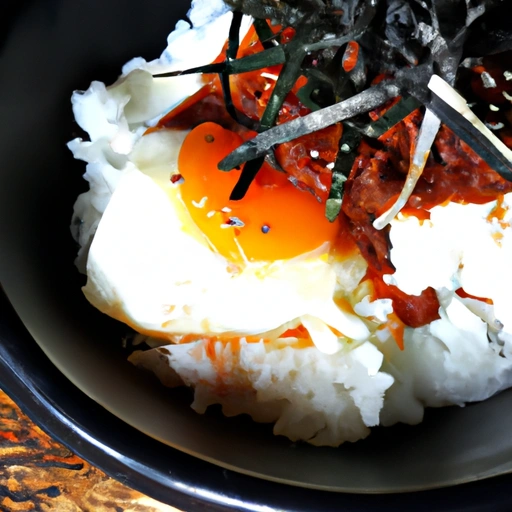Korean Bap
Korean Bap Recipe - Vegetarian Rice Dish from Korea
Introduction

Korean Bap, also known as Korean rice, is a staple dish in Korean cuisine. It is a simple yet delicious dish that can be enjoyed on its own or paired with various side dishes.
History
Bap has been a part of Korean cuisine for centuries, with rice being a key component of Korean meals. It is often served as the main dish, accompanied by various banchan (side dishes).
Ingredients
How to prepare
- Wash the rice in cold water 3-4 times.
- Place the rice in a rice cooker.
- Add water and cook.
Variations
- Add vegetables such as carrots, peas, or mushrooms to the rice for added flavor and nutrition.
- Mix in cooked meat or tofu for a protein boost.
Cooking Tips & Tricks
Use short-grain rice for the best results.
- Washing the rice multiple times helps remove excess starch and ensures a fluffy texture.
- Cooking the rice in a rice cooker is the easiest and most foolproof method.
Serving Suggestions
Korean Bap can be served with a variety of banchan, such as kimchi, pickled vegetables, and grilled meats.
Cooking Techniques
Cooking the rice in a rice cooker is the most common method, but you can also cook it on the stovetop.
Ingredient Substitutions
You can use brown rice or mixed grains instead of white rice for a healthier option.
Make Ahead Tips
You can make a large batch of Korean Bap and store it in the refrigerator for up to 3 days.
Presentation Ideas
Serve Korean Bap in a traditional Korean stone bowl for an authentic touch.
Pairing Recommendations
Korean Bap pairs well with grilled meats, stir-fried vegetables, and spicy kimchi.
Storage and Reheating Instructions
Store leftover Korean Bap in an airtight container in the refrigerator. Reheat in the microwave or on the stovetop with a splash of water.
Nutrition Information
Calories per serving
One serving of Korean Bap contains approximately 200 calories.
Carbohydrates
One serving of Korean Bap typically contains around 45 grams of carbohydrates.
Fats
Korean Bap is low in fat, with less than 1 gram of fat per serving.
Proteins
One serving of Korean Bap contains around 4 grams of protein.
Vitamins and minerals
Rice is a good source of vitamins and minerals, including niacin, vitamin D, calcium, iron, and thiamine.
Alergens
Korean Bap is typically gluten-free and dairy-free, but it may contain soy depending on the preparation.
Summary
Korean Bap is a nutritious dish that is low in fat and calories, making it a healthy choice for a meal.
Summary
Korean Bap is a simple and delicious dish that is a staple in Korean cuisine. With its fluffy texture and versatile flavor, it is a perfect accompaniment to any meal.
How did I get this recipe?
I can still recall the sense of amazement I felt when I first saw this recipe for Korean Bap. It was a rainy afternoon in Seoul, and I was wandering the bustling streets, my stomach rumbling with hunger. As I passed by a small hole-in-the-wall restaurant, the savory aroma of garlic and soy sauce wafted out, drawing me in like a moth to a flame.
Inside, I found myself surrounded by a diverse group of locals, all eagerly digging into big bowls of steaming rice topped with an array of colorful vegetables and tender slices of beef. The dish looked so simple yet so delicious, and I knew I had to learn how to make it myself.
I struck up a conversation with the friendly owner of the restaurant, a kind and elderly Korean woman who spoke broken English. Through a mixture of gestures and broken words, she somehow managed to convey to me the basic ingredients and steps needed to create this mouthwatering dish.
I scribbled down notes in my notebook, trying to capture every detail of the recipe. The key, she told me, was in the marinade for the beef – a mixture of soy sauce, sesame oil, garlic, and ginger that imbued the meat with a rich, savory flavor.
Back home in my own kitchen, I set to work recreating the Korean Bap recipe. I marinated the beef for hours, letting the flavors meld together and infuse the meat with their goodness. As the rice cooked on the stove, I chopped up an assortment of colorful vegetables – carrots, bell peppers, zucchini, and mushrooms – to add a burst of freshness and crunch to the dish.
Once everything was ready, I assembled the Korean Bap in a big bowl, layering the rice on the bottom and arranging the vegetables and beef on top. A sprinkle of sesame seeds and a drizzle of spicy gochujang sauce completed the dish, adding a final touch of heat and complexity.
I took a bite, and instantly I was transported back to that rainy afternoon in Seoul. The flavors were bold and comforting, a perfect balance of salty, sweet, and spicy. I felt a sense of satisfaction knowing that I had successfully recreated a taste of Korea in my own kitchen.
Over the years, I have continued to make Korean Bap for my family and friends, each time tweaking the recipe to suit my own tastes and preferences. I have added new ingredients, experimented with different cooking techniques, and even shared the recipe with others who have fallen in love with this dish as much as I have.
As I grow older, I realize that the true beauty of cooking lies in its ability to connect us with others – to transport us to faraway places, to evoke memories of past experiences, and to create new ones with those we love. And for that, I am eternally grateful to that kind Korean woman who shared her recipe with me all those years ago.
Categories
| Korean Recipes | Korean Vegetarian | Rice Recipes | Vegetarian Recipes |